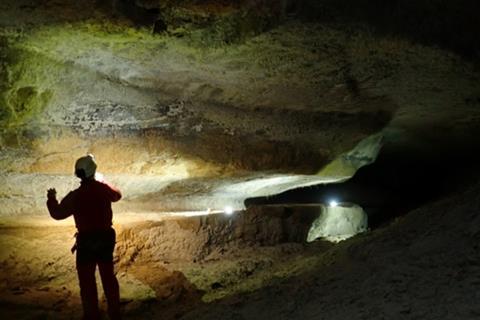Scientists have used isotopes of sulphur to fingerprint the sources of sulphuric acid that have carved unique and beautiful cave systems in the Pyrenees mountains of southern France.
Networks of caves form when carbonate rocks like limestone dissolve, also known as karsts. In most caves, water has trickled down through Earth’s surface, picking up carbon dioxide and becoming slightly acidic along the way—this is the same type of mild carbonic acid that you’ll find in a can of fizzy drink that has carbon dioxide dissolved in it.
A rarer type of cave forms from the transport of fluids up through the crust and through fault zones, creating vertical caves that can connect with horizontal caverns, forming large networks. In some cases, when sulphur is present, sulphuric acid forms and acts to dissolve limestone much faster - forming caves 10–100 times faster than its carbonic acid counterparts.

When sulphur compounds are present in water or in the minerals in the cave walls, chemical-loving bacteria use the sulphate as an energy source, producing hydrogen sulphide as a by-product. Oxidation of this hydrogen sulphide then forms sulphuric acid. Sulphuric acid can also come from hydrothermal springs or from minerals within the rock - both are true in the northern Pyrenees.
Sulphur isotopes
Sulphur comes in four different isotopes—each weighing a slightly different amount. Researchers were able to estimate the relative contributions of sulphuric acid from different sources by using these isotopes as a marker of where the sulphur originated.
The large network of limestone caves in the foothills of the French Pyrenees mountains were formed by a combination of acid-forming processes that left their imprint on the minerals left behind. Sulphur-containing minerals like gypsum and mirabilite in the caves hinted that sulphuric acid was involved in their formation. Mirabilite is a rare mineral that forms long, thin crystals up to 50 cm in length that radiate out like flowers.
For the first time, researchers studying limestone caves carved out by sulphuric acid have estimated how much of the cave-forming acid was produced by bacteria within the cave versus how much was produced by thermochemical processes. This innovation in separating the various sources of limestone dissolution has also allowed them to make the first estimate of how much carbon dioxide was emitted by the formation of the caves.
Hydrothermal springs
Dimitri Laurent of Université de Lorraine, lead author of this study, which appears in Geology, explains, “We tried to identify hydrothermal springs close to measured faults, and then we contacted the local speleological clubs to visit the caves near the springs. We see that at depth in the Northern Pyrenees, in the northern foothills, there are Triassic evaporites that produced hydrogen sulphide through thermochemical processes 65 million years ago.”
That hydrogen sulphide then travelled through fractures in the rock and has been trapped within the cave host rock since then. As water began to dissolve this sulphur-rich rock, the fossil hydrogen sulphide was liberated and oxidized to form sulphuric acid. The Triassic evaporites have also delivered sulphates to the caves more recently, via deep hydrothermal fluids, which are then used by bacteria within the cave.
Combining chemistry with physical observations of the landscape, the researchers reconstructed the history of how these spectacular caves came to be.







No comments yet